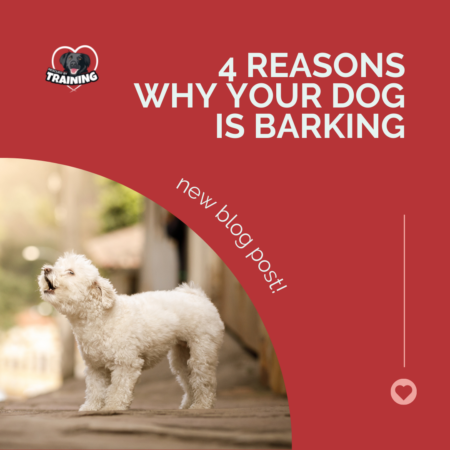Did you know that barking is completely normal dog behavior? While it may be annoying, especially if you’re working, it is your dog’s way of communicating. So let’s dive into why your dog might be barking.
- He wants something. This is demand barking. This type of barking happens when your dog wants something – your attention, food, toys, to go out, to get other dogs to play or other similar situations where your dog is trying to communication a need or want. Dogs who demand bark are not upset – they’re just trying to tell you they want something.
- He hears something and wants you to know about it. This is watchdog barking. Dogs who watchdog bark are also not upset. They are barking to tell you there’s something they think you should know about, like there’s a noise outside or they see someone walking by or someone is at the door. They’re communicating “Hey, did you know someone is outside? Just wanted you to know!”
- He’s afraid or anxious. This is spooky/anxiety Barking. This type of barking happens when a dog is upset or fearful. Dogs that spooky bark are barking to communicate to the threat (as they see it) to keep away or keep distance and not get any closer. This is part of a dog’s threat sequence and happens when dogs are afraid of people, dogs, noises or other triggers. This barking also pops out when the dog is feeling unsafe, commonly in dogs who are suffering with separation anxiety. In those dogs, the dog is afraid of being alone and is having a panic attack, so they’re vocalizing in distress.
- He’s bored. This is boredom barking. Barking is a great way for dogs to burn off energy so dogs that are unstimulated, under-enriched or not having their needs met, will boredom bark. Commonly this happens with dogs that are left outside unattended or inside homes for long stretches of time without adequate exercise, human or canine interactions and overall stimulation and engagement.
Which is which?
First, try to pay attention to when your dog is barking and what happened immediately before or what is currently happening. This will help you figure out what kind of barking is happening. In addition, observe your dog’s overall body language. Are his ears back? Is he barking and then retreating? What’s his tail position? Watching your dog’s body language can help you further determine if your dog is upset or not upset.
For many dogs, they will have different types of vocalizing. A demand bark might sound very different than an anxious bark so learning your own dog’s communication is key.
Figuring this part out – whether your dog is upset or not is critical because that will determine your training path. The ways we work to resolve or lessen the barking for a dog who is fearful is very different than how we work with a watchdog or demand barker who is not upset.
How can we reduce the barking?
Pro tip: Yelling at your dog when he’s barking won’t make him bark less. (This Harry Bliss comic is perfect.) And yelling at your dog could actually cause long-term behavior issues like fear.
Barking can be self-reinforcing, meaning the dog gets enjoyment (or reinforcement) from the act of barking, so barking doesn’t normally extinguish or go away on its own. Managing your dog’s environment, especially if they watchdog bark, with things like sound masking and window covers can help. If your dog doesn’t see or hear the triggers, he won’t go off at them. Download my free Dog Trainer’s Toolkit to see some of my top choices for management.
We can also train an alternate behavior, one that is incompatible with barking and that pays off better than barking. For barking where the dog is not upset, we can implement non-scary, non-painful timeouts, where we remove the thing the dog wants or put him in a timeout. This can be especially helpful for demand barking. But I will caution, we need to be very careful to not use force or scare the dog in the timeout process, so it’s best to work with a qualified professional and not just throw your dog into timeout without following a proper timeout protocol.
For dogs who are upset when they’re barking, we have to help them feel better about the thing they’re afraid of, whether it’s being alone, strangers, dogs, noises or anything else. Behavior modification like this requires a lot of nitty gritty detail work to help the dog feel better so you should schedule a separation anxiety assessment or a fear and aggression consult if your dog is having barking issues because he’s upset. And remember, we never punish a dog for communicating – behavior suppression isn’t behavior modification.
And lastly, if your dog is boredom barking, then we need to find ways to provide more enrichment, Enrichment isn’t a bonus activity – it’s part of providing a good quality of life to your dog. Dogs need outlets for normal dog behaviors and instincts like digging, chasing, sniffing, scavenging and hunting. Dogs are also an incredibly social species so most dogs thrive with human or canine companionship. Enrichment is a way to ensure all of your dog’s needs are being met. Enrichment isn’t optional. If your dog is communicating he’s bored, let’s work together to find ways to improve that dog’s overall quality of life.
If you need help, grab your one on one session with me here! And, be sure to sign up for my free weekly newsletter so you don’t miss out on free tips, videos, personal stories, client successes and more!
Happy training!
![]()




